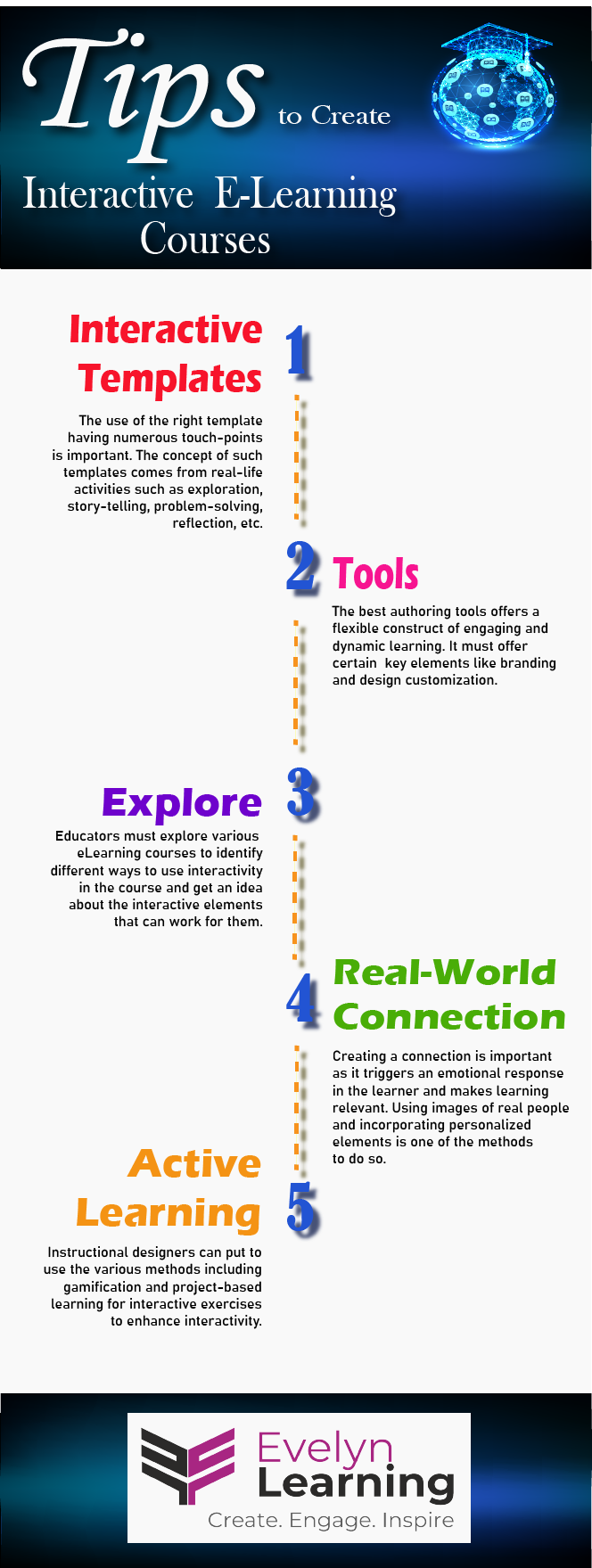eLearning, also known as the modern way of learning, refers to imparting education via electronic media that goes beyond the four walls of a traditional classroom. Its wide outreach makes it a more convenient and resourceful way of learning. However, with the growing demand for eLearning courses, instructional designers must use interactive elements to make these courses effective and learner-friendly.
Instructional design is evolving with the availability of a variety of methods and tools to develop instructions. As a result, we have an abundance of teaching-learning methods to choose from. Also termed teaching methodologies, these methods can be used to develop interactive courses. This article discusses the significance of interactive eLearning courses and provides some important tips to create an interactive eLearning course.
Tips to Create Interactive E-Learning Courses

1. Use Interactive Templates
The use of the right template with numerous touch-points is important. It effectively allows learners to interact with the content without the need for specific programming. The concept of such templates comes from real-life activities, such as exploration, story-telling, problem-solving, reflection, and so on. Different activities spanning across different categories can be designed. These include games, presentations, simulations, assessments, and more. The biggest advantage of using such templates is that it makes it easier to design eLearning courses and bring learning to life.
2. Use the Right Tools
Creating interactive courses does not always require a hefty spend. Instructional designers can easily create interactive courses with the help of various authoring tools available on the Internet. The best authoring tools offer a flexible construct of engaging and dynamic learning. It must offer certain key elements like branding and design customization, powerful learner data analytics, and dynamic video capabilities. Also, the tools must be able to make a compatible course to meet the needs of different learners. SCORM compatibility is also a necessary addition to the LMS.
3. Exploration is the Key
Before working to develop interactive courses, educators must explore various eLearning courses. This helps identify different ways to use interactivity in the course. Additionally, instructional designers can get an idea about the interactive elements that can work for them. Another benefit of such exploration is that it can help drive engagement to a course. This is thanks to the visual elements that attract more visitors and enhance retention. Moreover, these visual elements help connect to other pages through hyperlinks, enhancing overall learners’ engagement with the course content.
4. Connect to the Real World
Interactivity is all about bringing learning to life with the help of virtual reality. Although eLearning has comparatively fewer chances of interactivity, it can serve this purpose through a connection with the real world. Using images of real people and incorporating personalized elements is one of the methods to do so. Creating a connection is important as it triggers an emotional response in the learner and makes learning relevant. Consequently, their engagement and retention of the content increase.
5. Use Active Learning Techniques
Building interactive courses requires the use of active learning techniques. These techniques transform passive training into an active learning program. Instructional designers can put to use the various methods, including gamification and project-based learning for interactive exercises, to enhance interactivity. Another way of doing so is by introducing a character or avatar to bring a human touch to the course. Role-play is also an active learning technique for eLearning courses.
Importance of Designing Courses with Interactivity

Designing an eLearning course can be challenging at times. This is why instructional designers must be aware of the different ways that can be used to engage learners. The most crucial aspect of an eLearning course is its content. Course content must be relevant and valid in every eLearning course/training. It ensures that learners are on the right track in learning, but it is not the only aspect to be assessed. The level of interactivity of an eLearning course also determines its effectiveness. The more interactive the course is, the more engagement it drives from learners.
Moreover, with traditional learning methods becoming ubiquitous, eLearning courses are surfacing with new trends. The physical presence of an educator is no more a requirement for learning. However, this calls for an equal compensation of in-class interaction with the help of technology. This is why interactive courses become important. Interactive courses allow more engagement and better learning opportunities at the same time, thus favoring the educators and learners equally.
Read our article on e-learning to grasp a better understanding of the dynamics of e-learning.
Research Articles: E-Learning Industry and Lambda Solutions
Images: Shutterstock and pxhere
For more information on Interactive Learning, visit our blog. Create. Engage. Inspire.















